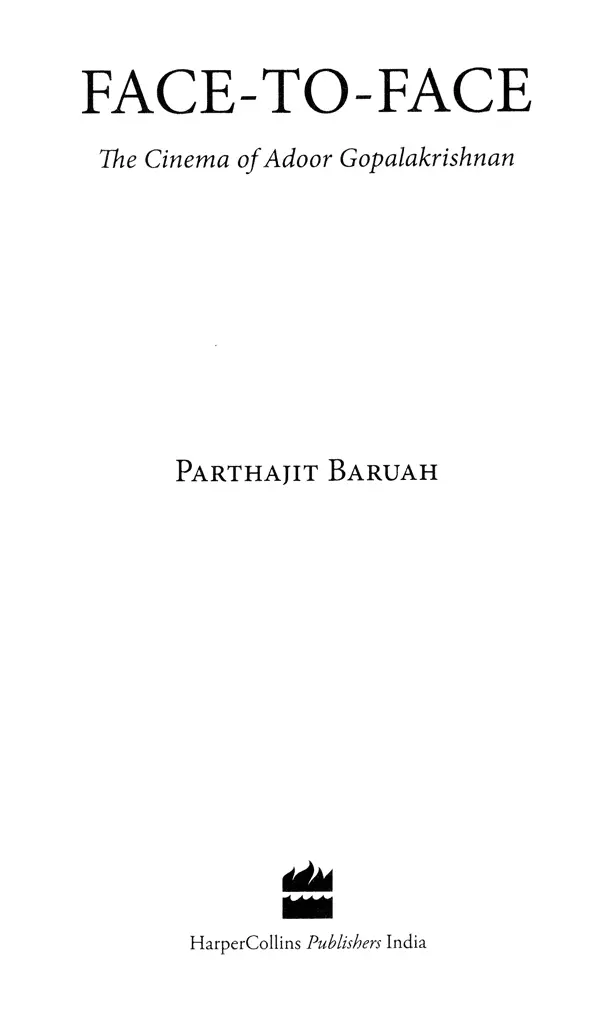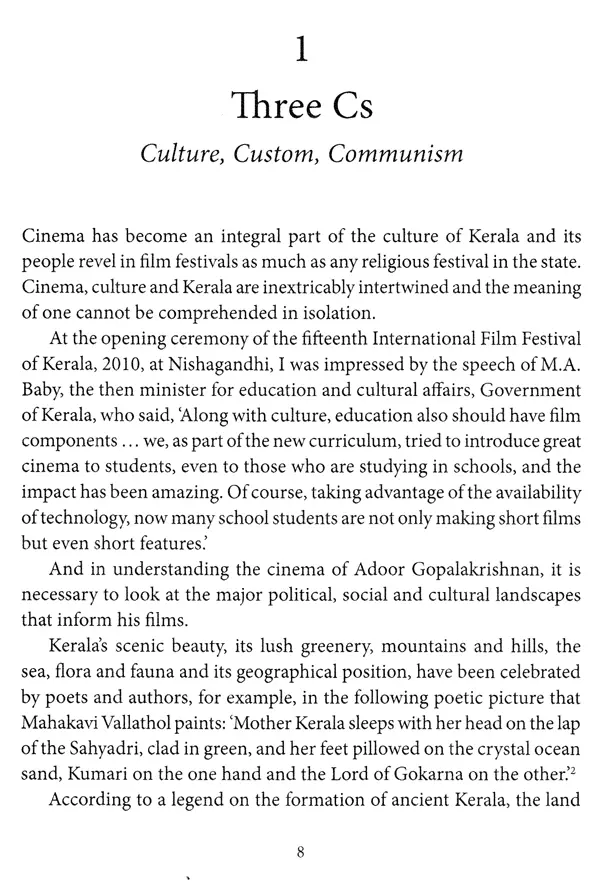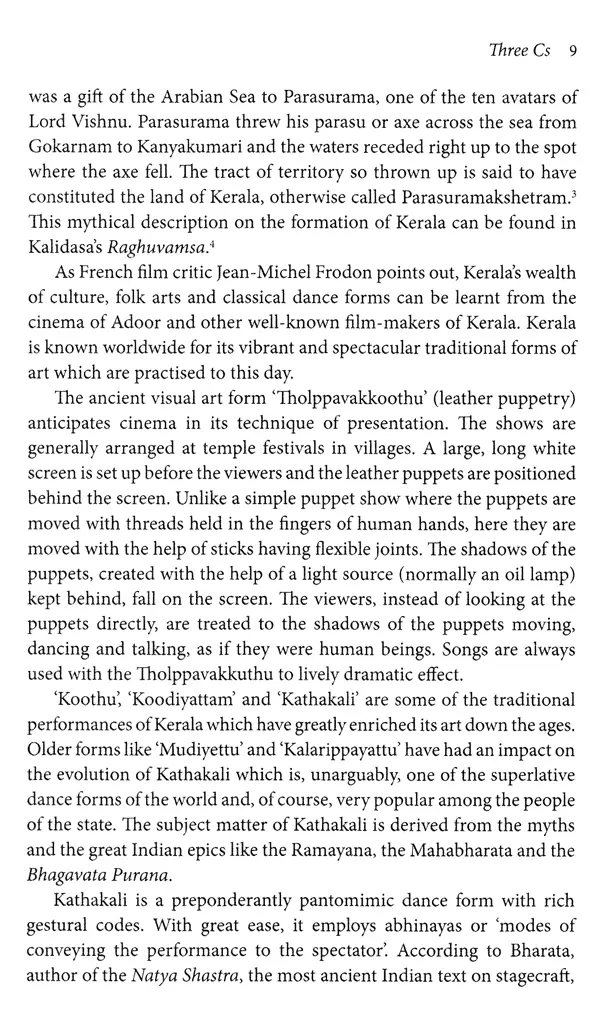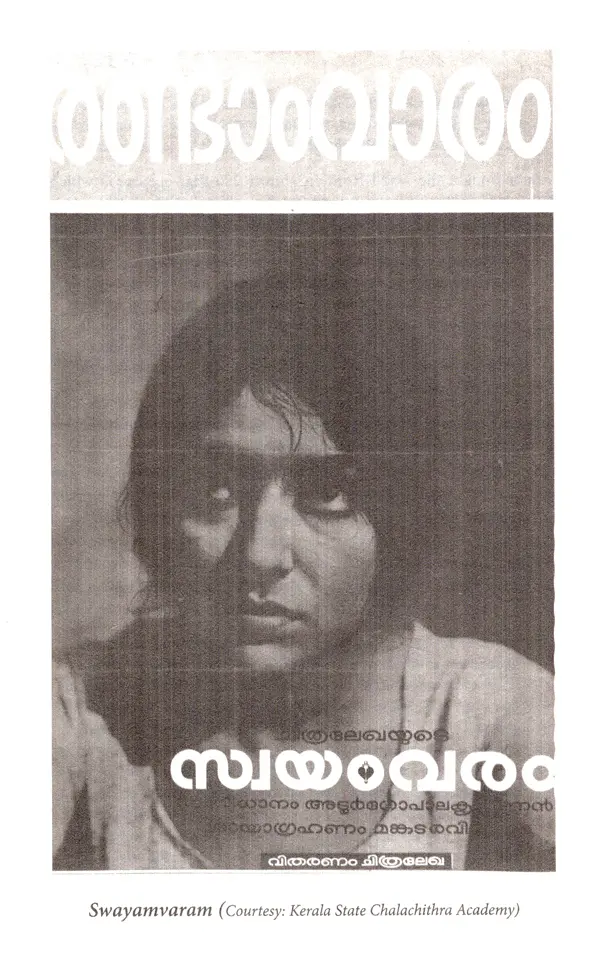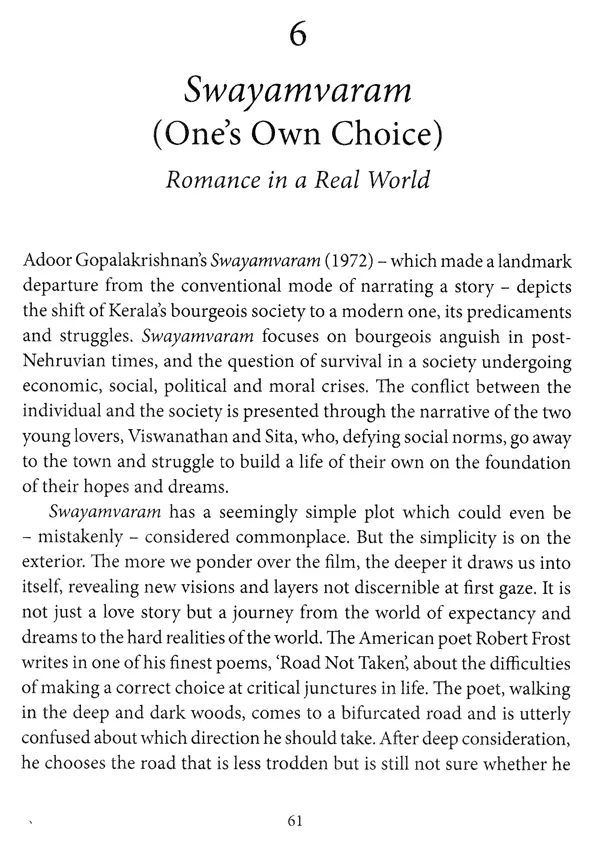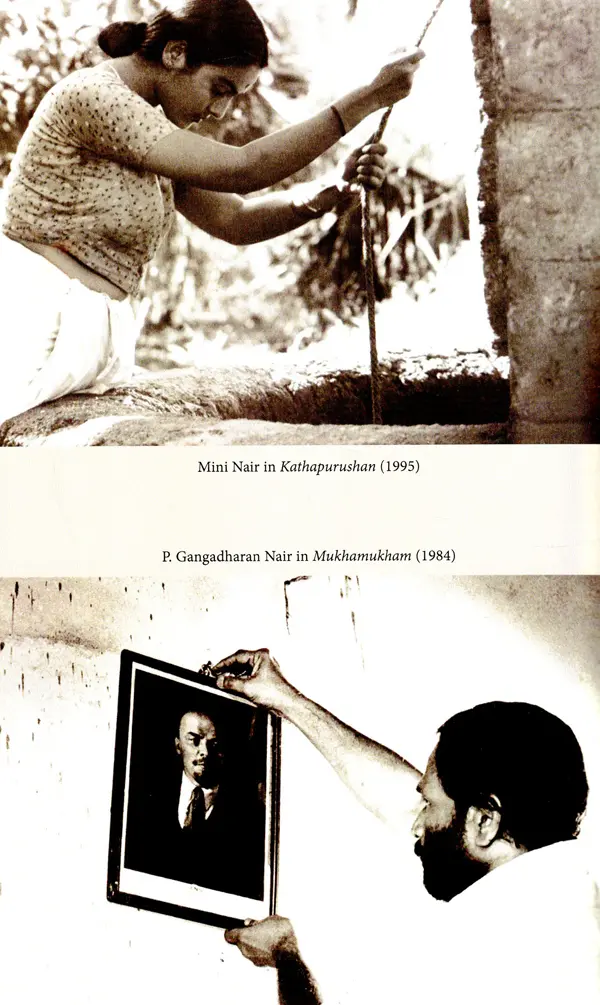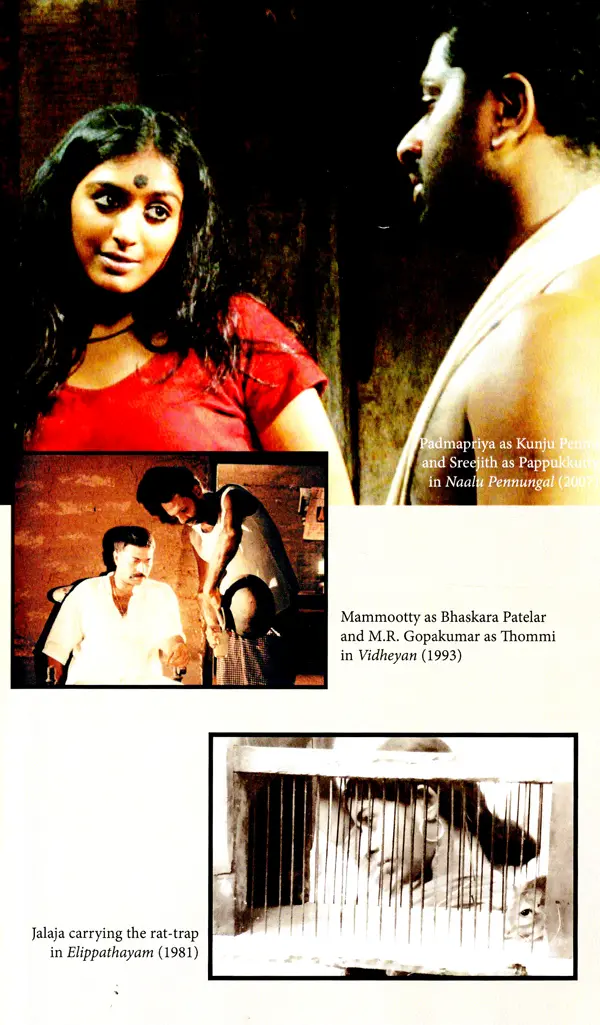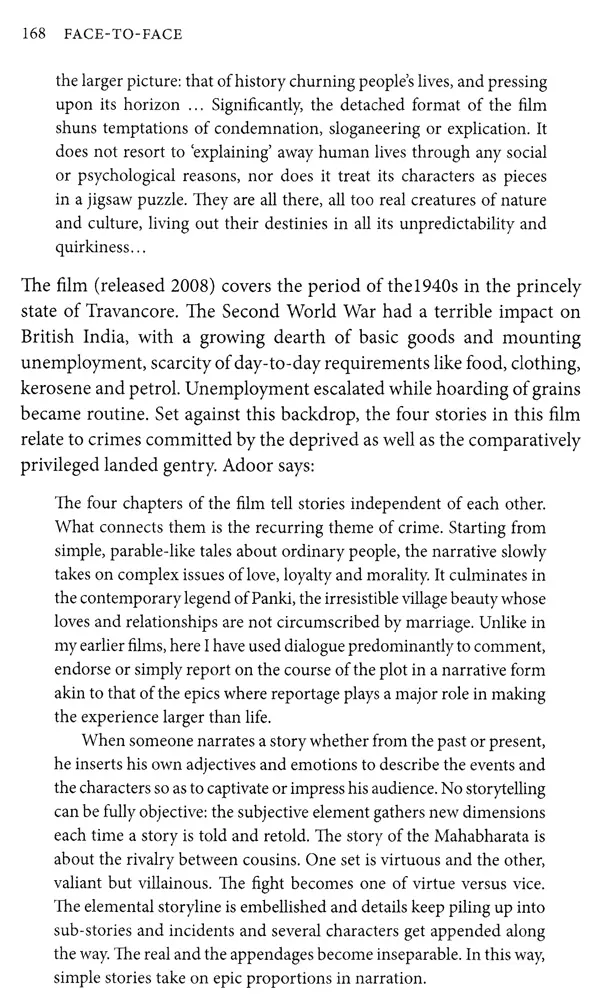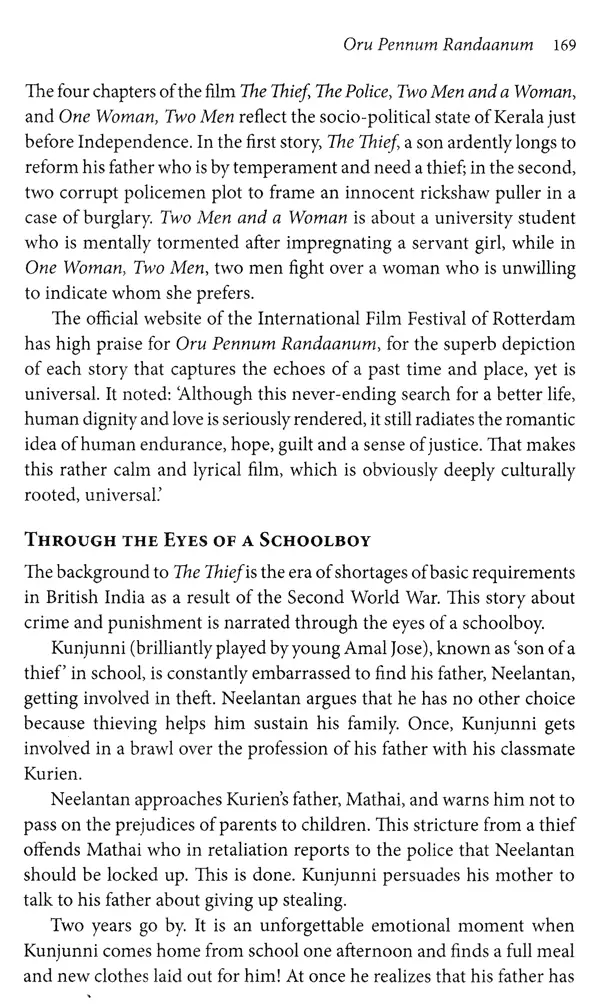
Face-to-Face (The Cinema of Adoor Gopalakrishnan)
Book Specification
| Item Code: | UAW644 |
| Author: | PARTHAJIT BARUAH |
| Publisher: | Harper Collins Publishers |
| Language: | English |
| Edition: | 2016 |
| ISBN: | 9789351361954 |
| Pages: | 220 (Throughout Color and B/w Illustrations) |
| Cover: | PAPERBACK |
| Other Details | 8.50 X 5.50 inch |
| Weight | 230 gm |
Book Description
Adoor Gopalakrishnan first put Kerala on the map of Indian cinema, and then Indian cinema on the world arena. He rewrote the rules of film-making in India with his highly original approach to craft and content. In a career spanning over four decades beginning with Swayamvaram in 1972 Adoor has made only. eleven movies, each one a triumph of artistic merit and integrity. His movies use the language of emotions and psychology to imbue the tales of ordinary lives with the true gravity of their human burden.
Face-to-Face is a critical introduction to the aesthetics of Adoor's cinema, his development as a film-maker. and his engagement with the culture, customs and history of Kerala. It is also a primer to his films, interpreting each one thematically and stylistically. With unlimited access to the master. Parthajit Baruah's well-researched narrative offers a fresh perspective on Adoor's cinematic discourse.
PARTHAJIT BARUAH did his postgraduation in English literature from Pune University. He later joined the film appreciation course at the Film and Television Institute of India (FTII), Pune. He received the 2010 Prag Channel Film Critic Award for Chalachitraor Taranga, a book on film theory, while his documentary on an abused young tribal woman, Laxmi Orang: Rising from the Grave, won him multiple awards at the Darbhanga International Film Festival. His second documentary, The Dhemaji Tragedy, won awards at the Delhi International Film Festival, the Film-North East Festival 2016, the 4th Kolkata Short International Film Festival 2015, the 3rd Indian Cine Film Festival 2015 and the 4th Delhi International Short Film Festival 2015. The Nehru Yuva Kendra, Assam, has conferred on him the Youth Icon Award 2016. He presented his paper 'Shakespeare and Assamese Cinema' at the Indian Shakespeares on Screen conference in London recently. He teaches English and cinema at the Renaissance Junior College in Nagaon, Assam.
Beyond the admiration and gratitude any cinephile - or I should rather say, any viewer- is likely to feel for Adoor Gopalakrishnan and his films, what does a foreign observer like me have to say about him, and them? Certainly unable to achieve the precise and knowledgeable understanding of his work that Parthajit Baruah shares in this book, I can only point out a few significant aspects of Adoor's cinema, and the way it appealed to me, and, I assume, to many non-Indian film lovers. Seen from afar, his films stand in a very specific place inside the huge modern current that vigorously swept cinema all over the world since the 1950s, from Italian Neo-realism and the French New Wave onward.
On that level, the specificity of Adoor's input was mostly noticeable with his second feature film, Kodiyettam, that is, more than the more explicitly neo-realist Swayamvaram. Schematically, I'd characterize this by the almost impossible fusion of two qualities which are so often separate, if not antagonistic: a subtle mix of deep humanity, empathy for the body and soul of humans as they are, and, at the same time, a stylized organization of storytelling, defying the usual rules of narration, choosing time and space instead of action and plot whenever needed, boldly affirming the abilities of cinema to open up the viewer's spirit, and to enhance and interrogate its relation with the world. It is most unusual that such an affirmed aesthetic option would cohabit with such a heartfelt relation with characters. Parthajit Baruah talks about Adoor's work as 'a voice of humanity who believes in the Gandhian principle. I confess I don't know much about Gandhian principles beyond superficial common knowledge, but obviously one from a different cultural background can relate with such an attitude towards mankind, social relations, and the world as a whole - including what westerners call 'nature' in a questionable separation of the cultural and social.
Adoor's very rare ability to associate stylistic elements with emotional empathy reaches an unparalleled peak with his masterpiece Elippathayam. Though effective with all characters, it is even more true with the depiction of Unni, the childish landlord. In terms of finding the fusion between stylization and sentiment, the only acceptable comparison I can think of is with Chekov stage plays, though with extremely different components. But, and this leads us far away from stage theatre, it is unfair to talk only about the human characters, though they are unforgettably moving, specially thanks to the clever lack of psychological explanation Unfair because one should also mention the house, the landscape, even the light and the sky of Kerala. Adoor's cinema is deeply rooted in a geographical and climatic setting, which is much more than a film set: elements of a world as active protagonists of happenings around.
As a foreigner who, at the time, had never been in Kerala - and, I should admit, was hardly aware of the existence of this state, not to speak about the ability to locate it on a map - there was the immediate discovery of a certain quality of green and blue, that is, of a certain relation between heat and rain, clouds and trees, and a certain tonality in a language, which, I learned only later, is called Malayalam. It is only at the end of this book, in the chapter dedicated to Nizhalkkuthu, that Parthajit Baruah has this subtle insight about the meaning of palmyra trees as witnesses. But, at least for foreign viewers raised and living where no palmyra tree naturally grows, it seems obvious that these trees, as well as the elevated paths circulating between the fields, the shadows in the traditional houses, all testify to the reality and the specificity of a certain world, or a certain state of our common world.
Ignorant as I was - as I am still, but a little less though, and ignorant as most Western viewers were and are - 'Indian cinema' meant either Satyajit Ray or Bollywood (with, hopefully, the discovery of one Guru Dutt and one Ritwik Ghatak movie). Now, with these Gopalakrishnan movies, we were elsewhere. The atmosphere had changed, the physical aspect of men, women and children had changed, the rules of the game had changed. And though not quite lost, the immense humanity of Adoor's point of view was opening access to this other world.
'You have been in the business of film-making for so long, yet why such few films?' This is a question I am asked very frequently. Little do these well-meaning souls know that it has been no easy path that I have traversed in making my eleven feature films in a career spanning forty years. One can hardly blame the curious questioner because he knows of many prolific directors capable of producing one film after another with no intervals between. While I salute the faith and capacity of directors who can deliver such products, I must add here that I do not appreciate those films which are made in the name of entertainment for the masses and designed solely to suit the market.
In India, where the so-called film industry prides itself on the fact that we churn out the largest number of films in so many languages, the term 'cinema' automatically refers to commercial cinema. Everything other than the standard products is an aberration and hence untouchable. They get no financing, no distribution, and so no exhibition either. The committed film-maker must have indefatigable faith and a strong will to struggle against all odds and still sustain his sanity in the face of various hostilities. Even if such a film-maker manages to make a film on his own, there is little chance of its getting shown in the theatres. And a national or international award for a film becomes a sure indication for the common man to avoid it!
In a bleak and hopeless scenario like this, the question, in all fairness, should have been, 'How did you manage to make those eleven films?'
In all probability the next question would be. So you make art movies?' To which, invariably, my humble answer is, 'No, I just make films the way I like to.
Adoor Gopalakrishnan has brought about a renaissance in the narrative technique of Indian cinema. This technique grew increasingly elaborate as he went on to become not only a staunch practitioner of India's alternative cinema but also one of the foremost film-makers on the map of world cinema.
Adoor is not handcuffed to the ethos of the twentieth and twenty first centuries; rather, he observes, probes and reflects upon the changes effected in the period his story springs from, giving it new shape and colour. The sense of belonging, of identity, of responsibility, the quest for selfhood, dreams and enchantments, the thirst and lust for power, identity crisis, spiritual progress or regression - are all themes that he explores and develops melodically in his films.
Adoor portrays the common man and his struggles to find his footing in a world ridden by political and social upheavals. His foremost concern is the capability of this man/woman to sustain and survive in such a world, to stand up against adversity, yet hold on to human values and moralities. But his visions can be optimistic: in spite of the harsh and bleak world that Sita (the female protagonist in Swayamvaram) faces after her husband's demise, she is not decimated by her circumstances - life doesn't come to a standstill for her. Rather, the film impresses on the viewer how Sita's strength of character helps her overcome adversities.
Book's Contents and Sample Pages
